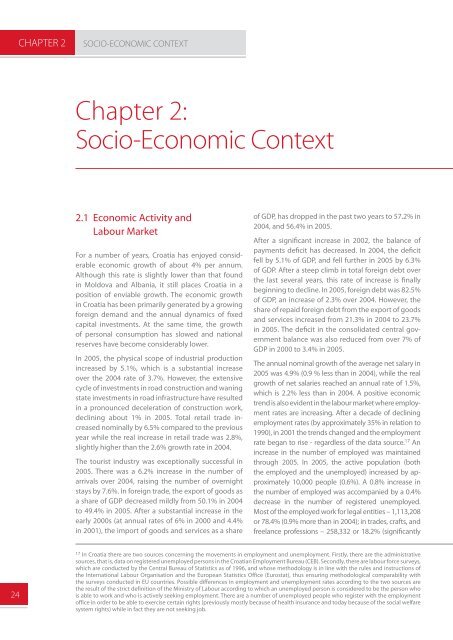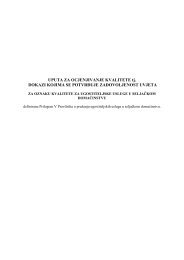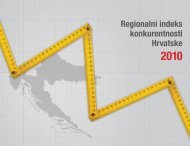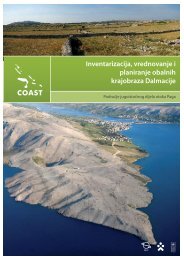WEB engleska verzija end.indd - UNDP Croatia
WEB engleska verzija end.indd - UNDP Croatia
WEB engleska verzija end.indd - UNDP Croatia
- No tags were found...
Create successful ePaper yourself
Turn your PDF publications into a flip-book with our unique Google optimized e-Paper software.
CHAPTER 2SOCIO-ECONOMIC CONTEXTChapter 2:Socio-Economic Context2.1 Economic Activity andLabour MarketFor a number of years, <strong>Croatia</strong> has enjoyed considerableeconomic growth of about 4% per annum.Although this rate is slightly lower than that foundin Moldova and Albania, it still places <strong>Croatia</strong> in aposition of enviable growth. The economic growthin <strong>Croatia</strong> has been primarily generated by a growingforeign demand and the annual dynamics of fixedcapital investments. At the same time, the growthof personal consumption has slowed and nationalreserves have become considerably lower.In 2005, the physical scope of industrial productionincreased by 5.1%, which is a substantial increaseover the 2004 rate of 3.7%. However, the extensivecycle of investments in road construction and waningstate investments in road infrastructure have resultedin a pronounced deceleration of construction work,declining about 1% in 2005. Total retail trade increasednominally by 6.5% compared to the previousyear while the real increase in retail trade was 2.8%,slightly higher than the 2.6% growth rate in 2004.The tourist industry was exceptionally successful in2005. There was a 6.2% increase in the number ofarrivals over 2004, raising the number of overnightstays by 7.6%. In foreign trade, the export of goods asa share of GDP decreased mildly from 50.1% in 2004to 49.4% in 2005. After a substantial increase in theearly 2000s (at annual rates of 6% in 2000 and 4.4%in 2001), the import of goods and services as a shareof GDP, has dropped in the past two years to 57.2% in2004, and 56.4% in 2005.After a significant increase in 2002, the balance ofpayments deficit has decreased. In 2004, the deficitfell by 5.1% of GDP, and fell further in 2005 by 6.3%of GDP. After a steep climb in total foreign debt overthe last several years, this rate of increase is finallybeginning to decline. In 2005, foreign debt was 82.5%of GDP, an increase of 2.3% over 2004. However, theshare of repaid foreign debt from the export of goodsand services increased from 21.3% in 2004 to 23.7%in 2005. The deficit in the consolidated central governmentbalance was also reduced from over 7% ofGDP in 2000 to 3.4% in 2005.The annual nominal growth of the average net salary in2005 was 4.9% (0.9 % less than in 2004), while the realgrowth of net salaries reached an annual rate of 1.5%,which is 2.2% less than in 2004. A positive economictr<strong>end</strong> is also evident in the labour market where employmentrates are increasing. After a decade of decliningemployment rates (by approximately 35% in relation to1990), in 2001 the tr<strong>end</strong>s changed and the employmentrate began to rise - regardless of the data source. 17 Anincrease in the number of employed was maintainedthrough 2005. In 2005, the active population (boththe employed and the unemployed) increased by approximately10,000 people (0.6%). A 0.8% increase inthe number of employed was accompanied by a 0.4%decrease in the number of registered unemployed.Most of the employed work for legal entities – 1,113,208or 78.4% (0.9% more than in 2004); in trades, crafts, andfreelance professions – 258,332 or 18.2% (significantly2417 In <strong>Croatia</strong> there are two sources concerning the movements in employment and unemployment. Firstly, there are the administrativesources, that is, data on registered unemployed persons in the <strong>Croatia</strong>n Employment Bureau (CEB). Secondly, there are labour force surveys,which are conducted by the Central Bureau of Statistics as of 1996, and whose methodology is in line with the rules and instructions ofthe International Labour Organisation and the European Statistics Office (Eurostat), thus ensuring methodological comparability withthe surveys conducted in EU countries. Possible differences in employment and unemployment rates according to the two sources arethe result of the strict definition of the Ministry of Labour according to which an unemployed person is considered to be the person whois able to work and who is actively seeking employment. There are a number of unemployed people who register with the employmentoffice in order to be able to exercise certain rights (previously mostly because of health insurance and today because of the social welfaresystem rights) while in fact they are not seeking job.

















